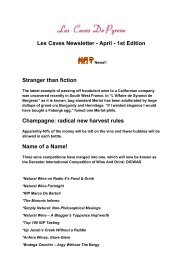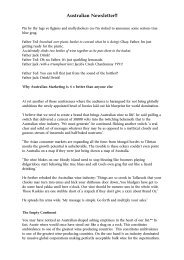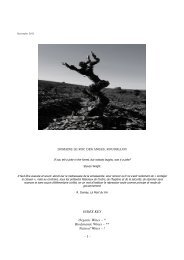Download our list here - Les Caves de Pyrene
Download our list here - Les Caves de Pyrene
Download our list here - Les Caves de Pyrene
Create successful ePaper yourself
Turn your PDF publications into a flip-book with our unique Google optimized e-Paper software.
FOOD OF THE SOUTH-WEST continued…Cassoulet S’il Vous Plait – 57 varieties – Beanz meanz duckzI love the cassoulet <strong>de</strong>bate. It mixes science and folklore, regional rivalry, fierce pri<strong>de</strong>, stubborn traditionalism.Eternal verities about food itself are enshrined in the <strong>de</strong>bate, the genius of cooking which is about taking the slowestand most <strong>de</strong>liberate of pains. Technicalities asi<strong>de</strong> the main ingredients are confit of duck leg, pork knuckle orbacon, sausage and broad beans. Be it from Toulouse, Carcassonne or Castelnaudary this is a rustic glutinous dishbegging for a wine of high acidity and digestible tannin, a Cahors, for example, or a red wine from Malepère, oreven a garrigue-scented Languedoc red.FromageRoquefort, the famous blue-veined ewe’s milk cheese matured in the limestone caves of Chambalou, <strong>de</strong>servesnothing less a brilliant Jurançon. And don’t forget the plump fresh figs. One talks airily of food and wine marriages,but this threesome represents connubial bliss. Salt, sweet, creamy, sharp, ripeness – the oppositions are sublimeattractions. Cabecou <strong>de</strong> Rocamad<strong>our</strong> is a silky goat’s cheese, milky when young, fruity and piquant when it isaffiné. Cabecous can be eaten in several ways; just as they are; semi-molten, having been passed un<strong>de</strong>r a hot grill,on toast or on leaves or on country bread drizzled with honey. A Sauvignon from Côtes <strong>de</strong> Duras or sharp youngGaillac works best. The cheeses of the <strong>Pyrene</strong>es are very fine especially the Ossau Iraty, the cow’s cheese Crottindu Poivre and the 100% sheep’s milk Ardi Gasna. Le Cabri-Ariegois is a goat’s cheese version of Vacherin,wrapped in thin strips of pine bark and with a washed rind. Finally, we should mention two cheeses from themountains of the Aveyron: Cantal and Laguiole, the historic former mentioned by Pliny the El<strong>de</strong>r, no less. Uncorky<strong>our</strong> best bottle of Marcillac – that’s what it’s t<strong>here</strong> for! Gaperon is from the Auvergne; it is flav<strong>our</strong>ed heavily withgarlic and pepper and ma<strong>de</strong> with skimmed milk or buttermilk. Look for the sweetest juiciest Gamay, bang it in thefridge and guzzle it with this rustic cheese.Minding Y<strong>our</strong> Prunes and QuincesGascony has a won<strong>de</strong>rful array of dishes to appeal to the sweetest of teeth. Traditional <strong>de</strong>sserts inclu<strong>de</strong> lesdaudines, a kind of pain perdu, millas (a Languedoc version with cornmeal porridge that is fried and sprinkled withsugar), otherwise crepes, waffles (gaufres) and the famous Gateau Basque. Clafouti with cherries, apricots andplums is an internationally renowned and frequently copied <strong>de</strong>ssert. Also justly famous are the crousta<strong>de</strong>s, pastisand t<strong>our</strong>tières, regional versions of pastry pies, filled with sweetened fruit and then baked. Using fruits in sav<strong>our</strong>ydishes has a rich tradition: the prunes and quinces that often feature in meat stews are part of the Moorish culinaryheritage that appeared in France by way of Spain many centuries ago. Roast figs, <strong>Pyrene</strong>an style are anotherseasonal treat. Prunes themselves are often marinated in Armagnac (or Sauternes) for a period before being ad<strong>de</strong>d to<strong>de</strong>sserts. Gateau Basque itself is a cake filled with pastry cream flav<strong>our</strong>ed with almonds, anise, rum, orange flowerwater and Armagnac. Sponge cakes such as ma<strong>de</strong>leines are fun to dunk in brandy or sweet wine. Sweet wine is notalways necessarily the i<strong>de</strong>al companion for sweet food: the combination can become cloying. Vins Doux Naturelswith a touch of bitterness – such as Muscat <strong>de</strong> Rivesaltes, Banyuls or Maury – are more appropriate. However, withsimple fruit pastries or a bowl of white peaches a glass of chilled Jurançon is a pleasure not to be <strong>de</strong>nied.Le Trou GasconTaste of the earth, dancing fire, velvet flame. If Cognac has finesse, Armagnac has fiery power, a hearty roughness– this is the distinction le trou Gascon will give you. Like the raw country wines from Gascony Armagnac roughensyou up, helps you to digest and leaves the day/evening open for further indulgence. A dash of the spirit will lift adaube or stew, cut the richness of a sauce or perfume and flav<strong>our</strong> fruits.“Happy and successful cooking doesn’t rely only on know-how; it comes from the heart, makes great <strong>de</strong>mands onthe palate and needs enthusiasm and a <strong>de</strong>ep love of food to bring it to life.”- Georges Blanc, from ‘Ma Cuisine <strong>de</strong>s Saisons’Lamb, veal, pork and game, ducks and geese, chicken and guinea fowl, truffles, cepes and mushrooms, chestnutsand cheeses, prunes and plums endless variants, <strong>here</strong> a Catalan influence, t<strong>here</strong> a Languedocian note, the terroirs ofLan<strong>de</strong>s, the Dordogne and Quercy all yielding their diverse signatures. Writing in generalities can’t do justice to t<strong>here</strong>gional vitality, the sheer diversity of the cuisine of the area that we call South West France. Moreover everyrecipe is a kind of history in itself and every family has its story to tell about the way it should be cooked. It wouldbe a mistake nevertheless to assert that things stand still. As recipes are han<strong>de</strong>d on, subtle refinements are ma<strong>de</strong>,sturdiness may be replaced by lightness, but the cuisine <strong>de</strong> terroir always remains close to the earth – each dishinvariably constructed around the strength of local ingredients. In the South West food and cooking is that mosttangible and sensuous necessity of people’s lives, writes Paula Wolfert. We believe that to appreciate fully thewines of the South West you must also experience the food and that the pleasure you take in the one nurtures a<strong>de</strong>sire for the other.- 14 -








